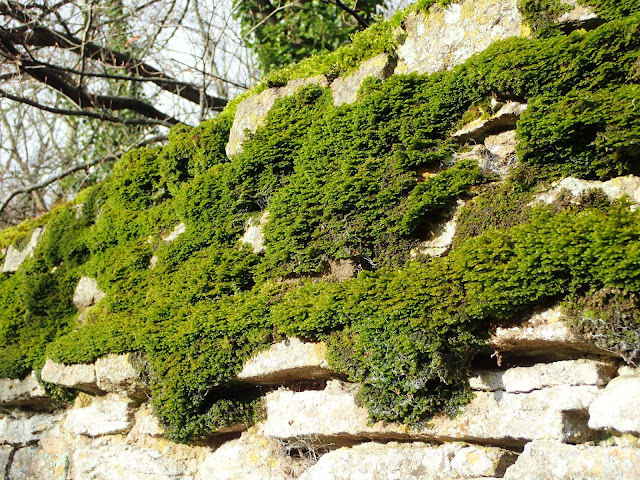For our third recording trip of the season, after two consecutive trips to nature reserves, we decided to focus on the wider countryside, plumping for the village of
Bletchingdon. A picturesque village in northern Oxfordshire built around a large green, adjacent to a
grand manor house in a Palladian style. The village is adajcent to the Oolitic cornbrash limestone bedrock, and as such we expected good hunting for bryophytes on the many limestone walls of the village. Indeed, although mainly intending to focus on
SP5018, we spent some time after arriving inspecting a fine wall along the road from the village green to the church. The wall had the fruiting feather (pleurocarpous) moss
Homalothecium sericeum above fine and extensive sheets of
Porella platyphylla, a liverwort that you may recall from our
last trip to Watlington Hill. The wall also yielded
Syntrichia virescens, among others; David picked this out from amongst the more abundant, larger,
Syntrichia montana. A later check under the microscope proved him right! This is a probably under-recorded species, only recognised as British in 1959. The 1998
Flora of Oxfordshire hedged its bets by labelling it "?rare".
 |
| Fine sheets of Porella platyphylla in the morning sun. |
 |
| Homalothecium sericeum in fruit at Bletchingdon. |
Hurrying on from the delights of this wall (we were in fact late to our official rendezvous point!), we then focused on the churchyard of St Giles for an hour or so. This included a range of graves of different stone, aspect, angle, and shadedness, resulting in a pretty good list. The highlight of the limestone headstones being some small patches of
Tortella tortuosa. A notable near miss was an infertile
Aloina species from the churchyard path; sadly these little acrocarps are unidentifable (at least without molecular techniques!) from infertile material, so this record remains at the genus level. Interestingly,
Aloina ambigua was recorded from Bletchingdon stone pit in 1945. The full list from the churchyard was as follows:
| Aloina sp. |
Orthotrichum affine |
| Barbula convoluta var. convoluta |
Orthotrichum anomalum |
| Barbula convoluta var. sardoa |
Oxyrrhynchium hians |
| Barbula unguiculata |
Phascum cuspidatum |
| Brachythecium rutabulum |
Plagiomnium undulatum |
| Bryum argenteum |
Pseudocrossidium hornschuchianum |
| Bryum capillare |
Pseudoscleropodium purum |
| Ceratodon purpureus |
Rhynchostegiella tenella |
| Dicranella varia |
Rhynchostegium confertum |
| Didymodon fallax |
Rhynchostegium murale |
| Didymodon insulanus |
Rhytidiadelphus squarrosus |
| Didymodon sinuosus |
Schistidium apocarpum s.l. |
| Grimmia pulvinata |
Thamnobryum alopecurum |
| Homalothecium sericeum |
Tortella tortuosa |
| Hypnum cupressiforme |
Tortula muralis |
| Hypnum cupressiforme var. resupinatum |
Zygodon viridissimus var. viridissimus |
| Kindbergia praelonga |
Metzgeria furcata |
|
Porella platyphylla |
The rest of the day was spent exploring SP5018, taking in a circular walk around the parkland of Bletchingdon manor, ultimately heading back into the village along the Kirtlington road. Overall we put a together a long list for the day, including
Neckera complanata and more
Porella together on a large ash stool,
Oxyrrhynchium speciosum on the edge of a small stream in woodland, and
Syntrichia papillosa on another large ash tree. On the way back to the village a stubble field was also worked over, although this yielded a fairly typical assemblage of
Barbula unguiculata,
Phascum cuspidatum,
Oxyrrhynchium hians, and the tuberous Bryum,
B. klinggraeffii. Both assemblages of fields in the calcareous parts of south-east Britain (see
Preston et al., 2010 [complete the "captcha" image text to access the paper]).
 |
| Neckera complanata growing on a wall with H. sericeum at Bletchingon Park |
Finally, arriving back into Bletchingdon, we spent some time grubbing around for urban ruderal species, adding
Brachythecium albicans and
Tortula modica from some unusually sandy soil behind kerbstones, followed by the classic wet tarmac species
Didymodon nicholsonii,
Ceratodon purpureus,
Bryum dichotomum and
Orthotrichum anomalum from a playground. A pre-Christmas pint soon followed! The full list from the wider 1km square was as follows:
| Amblystegium
serpens |
Grimmia pulvinata |
Rhynchostegium confertum |
| Barbula unguiculata |
Homalothecium sericeum |
Syntrichia laevipila |
| Brachythecium albicans |
Hypnum cupressiforme |
Syntrichia montana |
| Brachythecium rutabulum |
Hypnum cupressiforme var. cupressiforme |
Syntrichia papillosa |
| Bryum argenteum |
Hypnum cupressiforme var. resupinatum |
Syntrichia ruralis var. ruralis |
| Bryum capillare |
Isothecium myosuroides |
Thamnobryum alopecurum |
| Bryum dichotomum |
Kindbergia praelonga |
Tortula modica |
| Bryum klinggraeffii |
Leskea polycarpa |
Tortula muralis |
| Bryum moravicum |
Neckera complanata |
Tortula truncata |
| Ceratodon purpureus |
Orthotrichum affine |
Ulota bruchii |
| Cryphaea heteromalla |
Orthotrichum anomalum |
Zygodon conoideus |
| Didymodon insulanus |
Orthotrichum diaphanum |
Frullania dilatata |
| Didymodon nicholsonii |
Orthotrichum lyellii |
Lophocolea bidentata |
| Didymodon sinuosus |
Oxyrrhynchium hians |
Metzgeria furcata |
| Didymodon vinealis |
Oxyrrhynchium speciosum |
Porella platyphylla |
| Fissidens incurvus |
Phascum cuspidatum |
Radula complanata |
| Fissidens taxifolius |
Platyhypnidium riparioides |
|
Get in touch to be added to the mailing list, and see the
blog calendar for upcoming events.



We also have fissidens gracilifolius to add to the list from the churchyard. I had thought it could have been F. limbatus but the BBS moss recorder disagreed. It was on a shaded piece of limestone rubble embedded in a bank by the church.
ReplyDelete